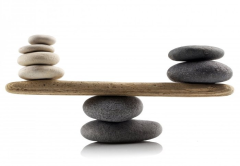Quarterly letter from the Department Chair
Fall 2017

Life out of balance. For the Cherokee, life is in order when it is flowing at an appropriate pace, unhurried and relaxed. Balance in life is the state of “tohi”: an even and steady fluidness in health and movement. Life reaches a proper state of perspective within each individual. The proper state of the individual is termed “osi”: conceived as upright, facing forward, and resting on a single point of balance1. Movement, walking, traveling through life–these are important metaphors for how we live. We can walk with minimal effort, smoothly reaching our goals, or we can hurry with a tense and energy-consuming stutter. When our movement or walking is disturbed, we experience disruption, imbalance and disease.
Neurological illness disrupts our movement, breaking it into halting steps or uncoordinated actions. After stroke, walking speed is slowed, movements are halting and disjunctive. Stroke patients may withdraw from community life. It is hard to get around your city if a person is still in the crosswalk when that number blinks down to zero. Physicians, researchers and staff in the UCLA Department of Neurology are pioneering ways to improve movement after stroke and other neurological illnesses. Their efforts to help patients recover include research into the mechanisms of recovery of walking in patients with stroke. One key to understanding how patients recover walking, or gait, ability after stroke is to be with them in their common, everyday moments. We cannot hope to fully understand how a person recovers from stroke or other illnesses if we just evaluate them in medical offices. Dr. Bruce Dobkin has been leading a team of neurologists, electrical engineers and physical therapists to develop wearable ankle sensors that measure the details of a person’s gait cycle and relay these movement signals through a smart phone to the UCLA lab. There, advanced computer analysis and machine learning approaches reveal how a person walks. This process allows Dr. Dobkin and his team to develop both individual movement maps and combined patient gait databases, and to pioneer new rehabilitation therapies that will stimulate improved walking patterns: smoother, more energy-efficient, and more natural. Read more about Dr. Dobkin’s work.
Recovering more natural movement is important for stroke patients to return to their community. Perhaps in our conception of medicine in Western society, we see walking and other movements as a means to an end: actions that bring us to our immediate goals. But natural movement is important for people to achieve a more balanced state in their lives.
A wise Apache woman once said:
“Do you want a long life? Well, you will need to have wisdom. You will need to think about your own mind. You will need to work on it. You should start doing this now. You must make your mind smooth. You must make your mind steady. You must make your mind resilient.”2
Human beings must move in smoothness, steadiness and with resilience. UCLA’s research into the control and recovery of walking after stroke leads the way towards a more effective gait and through this, a more balanced life.
1–Altman HM, Belt TN (2008) Cherokee History through a Cherokee Lens. Native South. 1: 90-97
2—Basso KH (1996) Wisdom Sits in Places: Landscape and Language among the Western Apache. University of New Mexico Press, pp 126-12
Inspired by On Trails: An Exploration, by Robert Moor, Simon & Schuster; 1st edition (July 12, 2016).